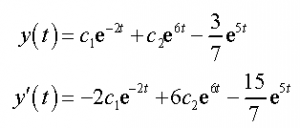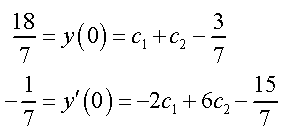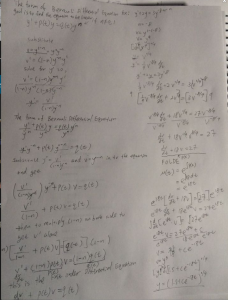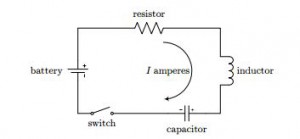You have probably seen first order linear equations. Now we”ll move to second order linear equations. What makes it linear? A differential equation is linear if it is a linear function of the variables y, y’, y” and so on.
The standard form of the second order linear equation is
y” + p(t)y’ + q(t)y = g(t)
where p(t), q(t), and g(t) are constant coefficients.
There can also be a constant coefficient in front of the y”.
When g(t) = 0, we can call the differential equation homogeneous, otherwise it is a non-homogeneous.
We can write the second order linear homogeneous equation can be written as:
ay”+by’+cy=0
From that, we can write that characteristic equation:
ar^2+br+c=0
From the characteristic equation, we can find the roots. The roots can come out to be real roots, repeated roots, or complex roots. But we will only focus on real roots.
How do we know if the roots are real roots? We can find out by find out the discriminant. To find out the discriminant, we use b^2-4ac. For the roots to be real, it must follow this condition:
b^2-4ac > 0
After finding out the roots, we can plug it into the general solution which is:
y(t)=C1e^(r1*t)+C2e^(r2*t)
Now we can figure out the derivative of the general solution which we’ll use later.
y'(t)=(r1)C1e^(r1*t)+(r2)C2e^(r2*t))
With problems like these, we will have initial condition, y(0) and y'(0), which will be used to find C1 and C2 to determine the particular solution.
You plug in the initial to determine C1 and C2.
Once you determined C1 and C2, plug them back into the general solution to get the particular solution satisfying the initial condition.
The initial conditions gives us a unique solution.
Example 1: y” + 5y’ + 6y = 0 y(0) = 2 y'(0) = 3
We start out with the characteristic equation which is:
r^2 + 5r + 5 = 0
Now find the roots anyway you feel comfortable with.
One way is by using the quadratic formula.
Now we got
r1 = (-2)
r2 = (-3)
We can plug it into the general solution
y(t)=C1e^(-2t)+C2e^(-3t)
Now that we have to figure out the derivative of general solution which will be:
y'(t)=(-2)C1e^(-2t)-3C2e^(-3t)
Now we can plug in the initial values which are y(0) = 2 y'(0) = 3
For the initial condition y(0) = 2:
2=C1e^(-2*0)+C2e^(-3*0)
2=C1+C2
For the initial condition y'(0) = 3:
3=(-2)C1e^(-2*0)-3C2e^(-3*0)
3=-2C1-3C2
Now that we have 2 equations, we can use them to solve for C1 and C2:
2=C1+C2
3=-2C1-3C2
Multiply the first equation by 2 so the C1 can cancel out.
4=2C1+2C2
3=-2C1-3C2
7=-1C2
C2=(-7)
Now that we know C2, we can plug it back into any of the two equations to find C1.
2=(-7)+C1
C1=9
Lastly we plug the C1 and C2 into the general solution to determine the particular solution.
y(t)=9e^(-2t)-7e^(-3t)
Videos to help with Second order linear homogeneous equations with constant coefficients:
This video is a transition from first order linear differential equations to second order linear differential equations.
This video goes into more detail when the roots are repeated or complex. It only goes up the general solution
In this video, he does a whole example using initial conditions.















